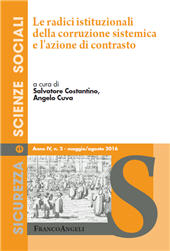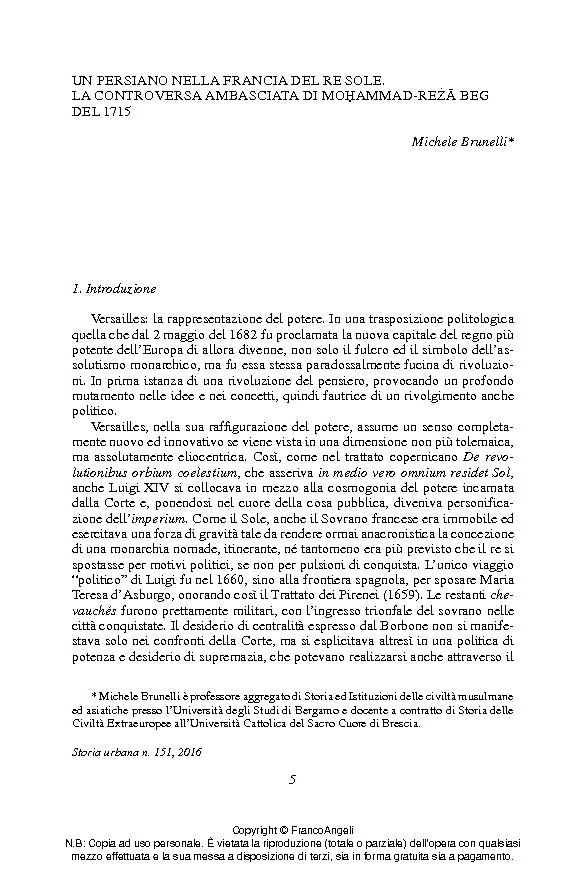Un persiano nella Francia del Re Sole : la controversa ambasciata di Moḥammad-Reżā BEG del 1715
5-61 p.
A Persian at the French Court of Louis XIV. The controversial embassy of Moḥ ammad-Reżā Beg in 1715 Moḥ ammad-Reżā Beg Persia Safavid dynasty French-Persian relations.
Nel 1714 un alto funzionario della corte safavide, Moḥ ammad-Reżā Beg, venne incaricato dallo Shāh di compiere una missione diplomatica a Versailles, nel tentativo di raff orzare le relazioni tra Persia e Francia. Partito da Erīvān nel marzo di quell'anno, dopo una serie di disavventure in terra ottomana, giungerà a Marsiglia solo nel mese di ottobre. Da qui inizierà una lenta risalita verso Parigi, per poi recarsi a corte ed essere ricevuto dal Re Sole. Lungo il tragitto, Moḥ ammad darà riprova del suo carattere iracondo e capriccioso, dei suoi tanti vizi e poche virtù. Lascerà un fl ebile ricordo della moda e dei costumi persiani ad una borghesia ed una nobiltà in cerca di distrazioni. La novità dettata dall'Orientalismo non basterà tuttavia ad evitargli un giudizio nettamente critico del suo scarso operato politico, non solo da parte dei suoi contemporanei, ma anche dei commentatori del secolo successivo. Il viaggio di Reżā Beg è comunque una testimonianza importante del tempo: innanzitutto poiché si tratt
a della prima ambasceria uffi ciale persiana in Francia, ma anche perché attraverso le varie fonti d'archivio e documentali si può apprezzare il primo impatto della conoscenza "dell'altro" da parte del popolo francese, sia delle grandi città, così come dei piccoli villaggi che il corteo toccherà nel suo tragitto verso nord, attraverso gli usi, i costumi, i modi e l'agire di questo personaggio controverso. [Testo dell'editore].
In 1714 the Shāh appointed Moḥ ammad-Reżā Beg, a high-ranking offi cial of the Safavid Court, to go on a diplomatic mission to Versailles: the goal was to strengthen the relationship between Persia and France. In March, of the same year, Moḥ ammad left his hometown Erīvān; after a series of misfortunes, he landed on Marseilles shores in October. From there, he began a long journey across France to get to Paris, in order to be introduced at the Court of King Louis XIV. Along the way Moḥammad gave prove of his hot-tempered and extravagant character, and showed his abundant faults as well as a few virtues. He left behind just a faint memory of the Persian fashion and habits to the French aristocracy and bourgeoisie, always eager of entertainments. Moḥammad brought the novelty of orientalism, but it was not enough: because of the poorness of his political commitment, he was harshly criticized not only by the people of his own time, but also by the commentators of the following century. Reżā Beg's travel, however,
represents an important testimony: to begin with, it was the fi rst offi cial Persian embassy to France; then, through sources such as archives and documents, it is possible to assess the fi rst impact "the stranger" made on the French people, both in big cities and small villages: as Moḥammad's parade moved up to the north, many had the chance to get close to this controversial character's way of life, his manners and deeds [Publisher's Text].
Fait partie de
Storia urbana : rivista di studi sulle trasformazioni della città e del territorio in età moderna : 151, 3, 2016-
Articles du même numéro (disponibles individuellement)
-
-
Informations
Code DOI : 10.3280/SU2016-151001
ISSN: 1972-5523
KEYWORDS
- Moḥ ammad-Reza Beg Persia Safavidi Relazioni franco-persiane



